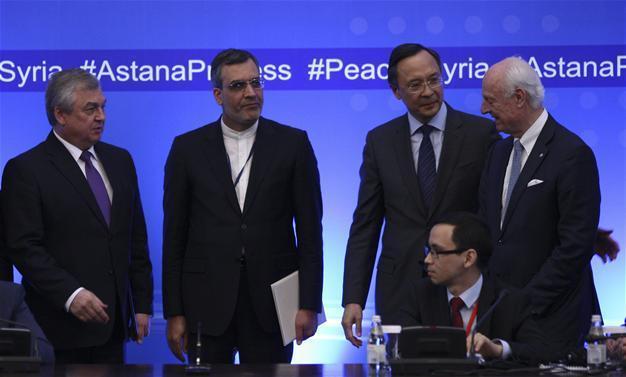Syria fighting eases as safe zones plan begins
BEIRUT – Agence France-Presse

REUTERS photo
Fighting subsided in Syria on May 6 after a deal signed by government backers Russia and Iran and rebel supporter Turkey to create four “de-escalation zones” began to take effect.The multi-phase plan, signed on May 4 in the Kazakh capital Astana, is one of the more ambitious efforts to end Syria’s six-year conflict.
It provides for a ceasefire, rapid deliveries of humanitarian aid and the return of refugees after “de-escalation zones” are created across stretches of eight Syrian provinces.
Those zones would see a halt to hostilities, including air strikes. The plan also proposes the deployment of “third-party” monitoring forces.
It began coming into effect at midnight on May 5, according to Russia, but co-sponsors have until June 4 to finalise the zones’ borders.
The four main battlegrounds covered are the northwestern province of Idlib, parts of central Syria, the south, and the opposition enclave of Eastern Ghouta near Damascus.
Some of those areas had already seen a drop in violence by May 6, and Russia’s defense ministry said Syria was “stable” at the end of the deal’s first day.
“We noticed there are fewer airplanes, almost none. People are buying and selling more,” said Abu Qais, a 26-year-old trader in Maaret al-Numan in Idlib province.
“Psychologically, residents are relieved,” he told AFP.
Syrian government warplanes could be heard from Eastern Ghouta around midday, according to an AFP correspondent in the rebel-held town of Douma.
The Syrian Observatory for Human Rights said government forces were clashing with rebels in the central province of Hama, dropping barrel bombs and firing artillery at opposition-held villages there.
“Despite these violations, we can still say that hostilities have dropped,” said Observatory head Rami Abdel Rahman.
The Britain-based Observatory said a child was killed in government shelling in parts of Homs province that fall within the de-escalation zones, the first civilian death in the zones since the deal began coming into effect.
Another seven rebel fighters were killed in other areas, up from an earlier toll of four.
Several ceasefires have been agreed since Syria’s conflict broke out in 2011, but they have failed to permanently stem the fighting.
The new deal was penned by Turkey, which mainly backs Syrian rebels, as well as Russia and Iran, which both support Syrian President Bashar al-Assad.
It was reached during negotiations to shore up a faltering truce deal brokered in December.
The agreement would initially last six months but could be extended by the guarantors.
It does not specify that the safe zones take effect immediately, but gives the three guarantor states two weeks to form working groups to delineate them and then until June 4 to come up with definitive boundaries.
Access to the areas will be controlled by security zones with checkpoints and observation posts.
The deal also calls for a continued fight against the ISIL and former Al-Qaeda affiliate Fateh al-Sham Front, which could pose challenges.
In Idlib province in particular, Fateh al-Sham is a major component of the rebel forces that control the area.
The Syrian government and rebel groups are not signatories, and both sides spoke vaguely on May 6 about “violations” of the agreement.
A senior military source in Damascus said the army had noted breaches but was waiting for the zones to be fully delineated.
And a member of the rebel delegation to the talks said the opposition was “recording violations of the deal committed by the regime and its militias.”
U.S. officials have given the deal a guarded welcome and have followed up its signing with several phone calls with Russia.
US Secretary of State Rex Tillerson discussed Syria with Russian Foreign Minister Sergei Lavrov on Friday, and General Joseph Dunford, chairman of the US Joint Chiefs of Staff, spoke with his Russian counterpart General Valery Gerasimov on May 6.
Russian and U.S. chiefs of general staff agreed to fully resume the implementation of a joint memorandum on preventing mid-air incidents over Syria, Russian news agencies quoted the Russian Defence Ministry as saying.
















